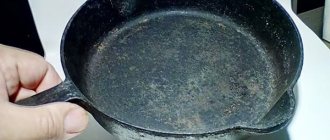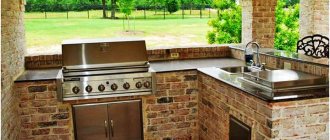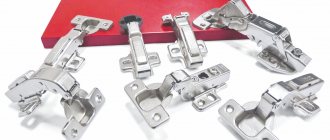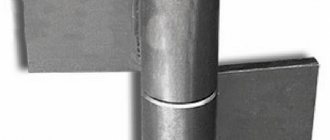Author's rating
Articles written
698
Author of the article
Vasily Mikhailovich Sviridov
home appliance repair technicians Salary from 80,000 rubles!
Published: 16-10-2018
Modified: 26-11-2018
Reading time: 6 minutes
This article has: (i)
Many apartments of old construction, especially from Khrushchev's times, are not able to accommodate all the household appliances necessary for kitchen life. When it seems that there is no more free space, built-in appliances come to the rescue. Let’s figure out how a dishwasher “feels” under the hob and which models are suitable for installation.
What types of dishwashers are there?
Manufacturers try to satisfy any consumer needs, so they produce different types of dishwashers:
- Stationary devices. These are free-standing machines that can be placed on the floor if they are full-size, or on a table if they are compact. They do not need fixation, they are self-sufficient. They can be moved from place to place. The main thing is to provide them with water and electricity.
- Built-in. Such machines can be installed in kitchen cabinets, under sinks, and countertops. They can be fully or partially built-in.
Installation Features
Installing and connecting a hob and oven is not a difficult task, but it requires a responsible approach. After all, these are devices with a high level of energy consumption that generate significant heat during operation.
Please consider the following before proceeding with installation.
Wiring condition
Connecting a powerful stove and oven to old electrical wiring will inevitably lead to short circuits and malfunctions in the operation of the appliances. Therefore, before connecting new equipment, the old wiring is changed.
When replacing wiring, experts recommend separating the lighting and power circuits. The more energy-intensive equipment you plan to install in the kitchen, the more power circuits you will need.
Attention! Powerful hobs and ovens are connected to dedicated power lines from the electrical panel.
Stoves and ovens consume a lot of electricity - from 3.5 to 10 kW. Therefore, the standards provide for dedicated sockets for them with a separate power line from the switchboard. If the hob and oven are installed independently, a separate socket with a dedicated connection to the panel is installed for each device.
Installing an outlet
After updating the electrical wiring, begin installing the outlet.
Selecting a location
When determining the location for the outlet, choose a location either next to the device, or above it at a distance of about 10 cm, or above the floor at the level of the legs.
Important! The socket box and other auxiliary equipment are not placed directly behind the electrical appliance.
It is most convenient to place the outlet on the right or left of the oven or hob.
Installation
There are hidden and external installation of the socket. The placement method is chosen taking into account the type of room and user preferences. It should be taken into account that in wooden houses all electrical wiring is installed externally, and electrical appliances are left open.
If the house is brick or panel, use any of the installation methods. Hidden installation is preferable from the point of view of safety and aesthetic appearance. But if it is not possible to ditch the walls, the socket is installed externally and the wires are covered with cable ducts.
Plug and socket selection
The average power consumption of a stove and oven is 7-8 kW, which corresponds to an electric current of 32-38 A. Therefore, a regular plug, which is used to connect, for example, a hair dryer, is not used for the hob. To connect such powerful equipment, special power plugs and sockets are used.
There are two types of power plugs on sale: black (made of carbolite) and white (made of plastic). White ones are of better quality and last longer. Both types are of the same design and are connected identically.
When choosing a socket for the hob and oven, they rely on the characteristics of the equipment itself. These devices come in both single-phase and three-phase and have energy consumption ratings from 3.5 to 10 kW.
Space for oven and panel
The hob is usually mounted in the countertop above the oven cabinet. This placement is convenient for the housewife and allows for economical use of kitchen space.
The built-in electric oven is placed in a special niche of the kitchen unit. The dimensions of the cabinet should be 10 cm larger on each side than the device itself. This will ensure proper ventilation of the equipment.
After placing the oven in the niche, check whether the surfaces of the unit are in contact with the walls of the furniture set.
Placement principles
To ensure that the dishwasher works properly, when installing, consider the following nuances:
- There should be an optimal distance between the surfaces of the devices - the stove and the dishwasher. It is necessary to leave space for placing layers of moisture and heat insulation.
- The installation location should be near the sink. Then it will be convenient to remove leftover food and rinse dishes if necessary.
- PMM is placed between cabinets - this way the equipment is more securely fixed, and the panel crashes into the countertop.
- It is recommended to place dishwashers near dish drawers so as not to run around the kitchen with washed dishes.
Installation under electric or induction hob
For this purpose, a fully built-in model is more suitable than others. Such PMMs are more compact; their package includes everything needed for installation, as well as thermal insulation material. The best option is induction cookers; they hardly heat up and the dishwasher is not in danger of heating up. When installing devices, keep these tips in mind:
- There should be at least 2.5–3 cm between the surfaces of the devices.
- Place a sheet of foil on the inside of the tile - this will act as a moisture barrier.
- The recommended height of the PMM is up to 82 cm. The height of countertops is usually 89–90 cm. Consider your height and the height of the pots you want to look into.
- Leave free space near the back surface of the device - hoses and other communications will be connected there.
- Adjust the PMM legs - there should be air circulation under the bottom. The gap from the floor to the bottom is 1 cm. This space will prevent the device from overheating.
- Do not rush to install the device, first make a drawing, calculations and measurements.
Features of the induction panel
An induction cooker is a more advanced version of a conventional electrical panel. It combines all the advantages of its predecessor and minimizes the disadvantages. However, the differences between them are significant, despite the fact that they both require electricity to heat the burners.
Difference from electric stove
As mentioned above, an induction cooktop falls under the category of electric stoves. But its operating principle is significantly different from a conventional electric oven, in which the heating element is first heated using electricity, and then the hot spiral gives off its heat to the dishes standing on it.
In an induction cooker, current is supplied to coils, which, unlike heating elements, do not heat up, but create a magnetic field that also remains cold. But as soon as an object with specific ferromagnetic properties comes under this radiation, it immediately begins to heat up. The bottom of metal cookware specially designed for cooking on an induction cooker has these qualities. In this case, only the area of the hob that is affected by the heat of the frying pan or pan standing on it is heated.
Important! People with a pacemaker should remember that it responds to a magnetic field at a distance of 30 centimeters from the radiation source. Therefore, purchasing such a hob is not recommended. Otherwise, you should not approach it closer than 33 centimeters, since the field also extends above the burner.
Features of work
When purchasing an induction oven to install it above the oven, you should take into account the operating features of such a device.
- The energy consumption of an induction surface is 1.5 times less compared to a conventional glass-ceramic electric stove. But still, when connecting it to a 220 V power supply network, you need to take care of an input circuit breaker and a power socket rated for a current of at least 32 A, as well as a residual current device, which is controlled by residual (differential) current.
- The magnetic field of the induction coils ceases to operate three centimeters from the surface of the burner. Therefore, you should avoid placing any electrical appliances nearby.
- For cooking on an induction hob, only cookware with ferromagnetic properties and a perfectly flat bottom is suitable. A curvature of even 1 mm simply will not allow the device to turn on.
- The fan cooling the stove creates a small noise level.
Advice! You should refrain from leaning on an induction oven that is turned on, since in its operation it uses the same waves as a microwave oven, and their effect on the human body has not yet been fully studied.
We put the PMM under the gas stove
This option comes with complications:
- To avoid excessive heating of the dishwasher, you need to accurately calculate the distance between the devices and their sizes.
- It is necessary to ensure free supply of hoses to the device - kinks and kinks are not allowed.
- Due to the large thickness of the panel, it may be difficult to install the machine.
- It is important to provide enhanced thermal insulation. For example, using foil foam. This material, having low thermal conductivity, will reflect thermal radiation. At the same time, penofol has water-repellent and vapor-proof properties.
How to embed PMM?
To install the equipment, you need to stock up on a jigsaw, chisel and mallet. And also a screwdriver, drill, ruler, pencil. A drill is necessary for drilling holes - for self-tapping screws.
Necessary materials:
- Laminated chipboard - in accordance with the color of the furniture.
- Metal corner.
- Fastenings - for fixing the body of the device.
Step-by-step instructions for embedding PMM:
- Measure the size of the niche in which the dishwasher will stand. Compare the obtained dimensions with the dimensions of the PMM. In order for the device to fit comfortably in the section, you need to know its exact dimensions, down to the millimeter. There may be small protrusions on the body - they must be taken into account.
- Decide on the exact location of the device in the section. Mark where the inner walls will be.
- Cut the grooves at the bottom of the niche. Their width should be equal to the thickness of the inner walls. Adjust the walls to size - they must correspond to the depth and height of the section. It happens that the role of the second inner wall is assigned to the side wall of the niche, then it is enough to make one cut. There should be 2–3 cm between the walls of the niche and the door of the pencil case.
- Install the inner walls. Secure them at the top using the inner corners.
- Place a front on the dishwasher door.
- Enter the PMM into the section. If necessary, secure it.
- Turn on your device. Before this, of course, it must be connected to the water supply, drain, and electrical network. Check its operation.
The result is both practical and aesthetic. The advantages of this solution:
- Kitchen space is saved.
- The dishwasher is hidden behind double walls and two doors - this makes its operation almost silent.
Overview of suitable models
To install under the hob, it is better to choose a built-in model - full-size, narrow or compact.
Weissgauff BDW 6083 D
Large machine with display and electronic control. Consumes 0.93 kW/h per cycle. Noise at 49 dB. Drying type: condensation. There is a clean water sensor. Delayed start timer - up to 24 hours. The use of tablets is provided. There is a beam indicator on the floor. Specifications:
| Type | full size |
| Installation | fully built-in |
| Capacity, sets | 14 |
| Energy consumption | A++ |
| Washing/drying | A/A |
| Water consumption per cycle, l | 10 |
| Dimensions (WxDxH), cm | 59.8x55x81.5 |
| Programs, pcs. | 8 |
| Approximate cost, rubles | 20 000 |
The advantages that the owners of the model wrote about in their reviews:
- high-quality washing;
- there is a backlight;
- roomy;
- works quietly;
- affordable price;
- stylish design;
- basket height adjustment;
- many useful programs;
- there is soaking;
- high energy consumption class.
Users did not mention any shortcomings - they simply did not identify them during the operation of the device. You can trust the quality of this machine - inexpensive but reliable equipment.
Indesit DISR 16B - narrow
One of the most popular PMMs. Consumers deservedly appreciated the combination of affordable price, quality and functionality. A standard wash lasts 180 minutes. Energy consumption - 0.83 kW/h. The model is somewhat noisy - 51 dB. Condensation drying type. A full range of programs - there are standard and special ones. Partially protected from leaks. Weighs 31.5 kg. Specifications:
| Type | narrow |
| Installation | fully built-in |
| Capacity, sets | 10 |
| Energy consumption | A |
| Washing/drying | A/A |
| Water consumption per cycle, l | 10 |
| Dimensions (WxDxH), cm | 44x55x82 |
| Programs, pcs. | 6 |
| Approximate cost, rubles | 16 000 |
A budget model in which users, in addition to the moderate cost, noted the following advantages:
- simple controls;
- moderate noise;
- roomy;
- high-quality assembly;
- many useful programs.
Minuses:
- the use of “3 in 1” tablets is not provided;
- not very high-quality washing in ECO mode;
- lack of display;
- no half load.
Flavia CI 55 HAVANA - compact
This small machine is quite suitable for being built under the hob. It is electronically controlled and equipped with a display. The water heater is instantaneous. Consumes 0.61 kW/h per cycle. Noise - 52 dB. Partial protection against leaks. You can use three-in-one tablets. A one-hour program is provided. Technical specifications:
| Type | compact |
| Installation | fully built-in |
| Capacity, sets | 6 |
| Energy consumption | A+ |
| Washing/drying | A/A |
| Water consumption per cycle, l | 7 |
| Dimensions (WxDxH), cm | 55x50x43.8 |
| Programs, pcs. | 7 |
| Approximate cost, rubles | 16 000 |
Advantages noted by owners of the compact machine:
- affordable price;
- compactness plus built-in - ideal solution for a small kitchen;
- works quietly.
Disadvantages and recorded breakdowns:
- two years later the control module broke down - this is almost half the cost of the device;
- after a year and a half of operation, the rinse aid does not supply;
- does not respond to the delayed start button and program selection;
- Economy mode lasts too long - 215 minutes;
- if the powder is cheap, it does not wash dishes;
- Doesn't clean the inside of mugs well.
Candy Trio 9501
Three in one. Having purchased such a device, you don’t have to worry about installing a dishwasher under the stove. This universal technology already contains everything:
- gas 4-burner stove;
- electric oven with grill;
- dishwasher with a capacity of 6 sets.
The volume of the PMM chamber corresponds to the capabilities of compact dishwashers. This type of machine is enough for a small family; you can’t fit a lot of pots and pans here. There are 5 programs. Water consumption per cycle is 9 liters. Approximate cost: 76,000 rubles.
Is it possible or not?
Modern kitchens consist of many built-in drawers, in which not only dishes are hidden, but also various electrical appliances. In the instructions for each dishwasher model (DMM), manufacturers indicate the conditions for placing this appliance in the kitchen. The main rules are:
- Do not place the dishwasher next to the stove or under the oven;
- it is better to create an air gap around the dishwasher of about 40 cm, which can be used as an additional compartment for storing dishes;
- The dishwasher must not be placed under or next to the sink.
- It is not recommended to place the PMM under the hob, even if it has a heat-insulating backing;
- you should fix the dishwasher on both sides, securing it between the drawers of the built-in kitchen, which have rigid fastenings
- The dishwasher must not be placed in the outermost compartment of the kitchen furniture set.
The dishwasher is not placed with the oven, preferring to install the electric stove at a distance of at least 15 cm from other household appliances. This is necessary so that the air between the devices can circulate normally, since after heating from the operating device it must be cooled.
If you place the dishwasher next to the oven, the hot air coming from the electrical appliance will hit the side surface of the PMM and heat it, as well as the microcircuits inside the device. The rubber seals that will heat up first will prevent water from leaking out of the dishwasher. With constant heating and subsequent cooling, other components of the unit will stop working.
The same effect will be observed when placing the dishwasher under the oven. Some manufacturers believe that you can install the dishwasher next to the stove in a pencil case, which will protect it from overheating.











